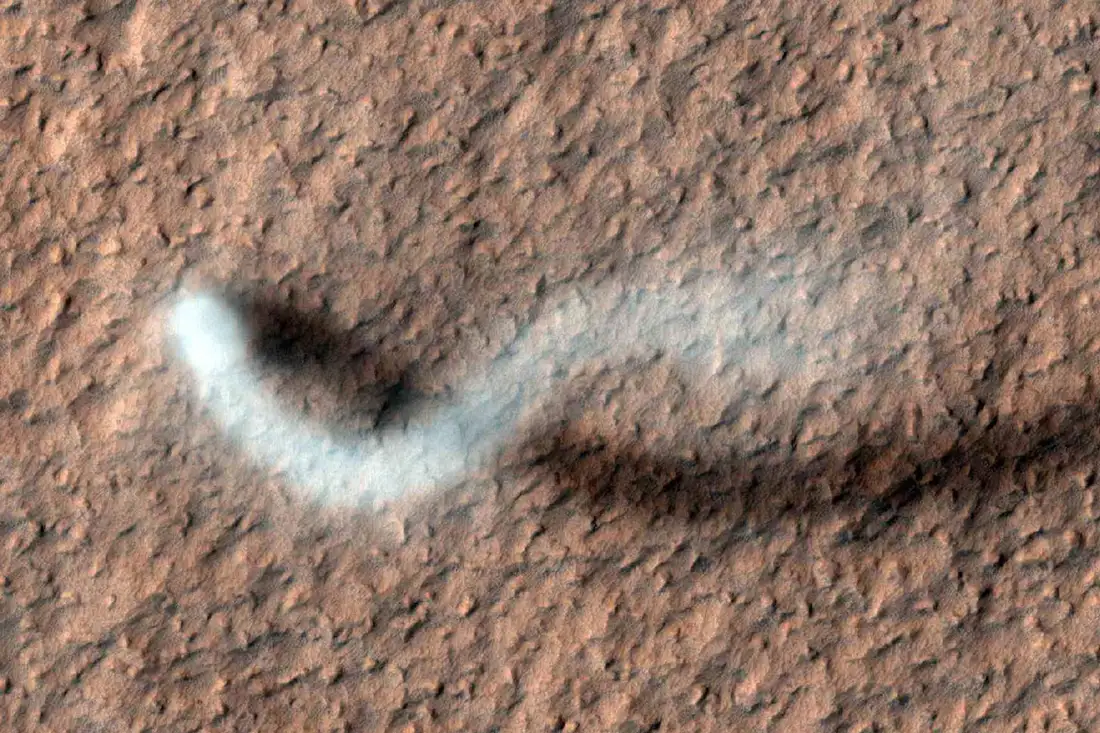Science
Mars Dust Devils Unleash Winds Surpassing 100 mph, Study Finds

Recent research reveals that dust devils on Mars can generate wind speeds exceeding 100 mph (160 km/h). This finding, led by Dr. Valentin Bickel from the University of Bern, highlights the significant impact of Martian dust devils on the planet’s atmospheric dynamics. The study was conducted in collaboration with researchers from multiple institutions, including the Centre for Earth, Planetary, Space and Astronomical Research (CEPSAR) and the German Aerospace Center (DLR). Their findings were published on October 8, 2025, in the journal Science Advances.
Dust devils are common phenomena on Mars, resembling their Earth counterparts. They form when surface heating causes changes in air pressure, creating a vertical column of wind. This vortex lifts dust, transporting it across the Martian surface. Despite its thin atmosphere, which is less than 1% that of Earth’s, the low gravity on Mars allows these dust devils to grow larger than those found on our planet.
The research team utilized images captured by the ExoMars Trace Gas Orbiter and the Mars Express spacecraft to analyze wind patterns more effectively. Using advanced machine learning techniques, they identified dust devils in over 50,000 satellite images. According to Dr. Bickel, “Our study is therefore based exclusively on data from European Mars exploration.”
To further their analysis, the scientists examined stereo images from 300 identified dust devils. By sequencing these images, they measured the movements and velocities of the dust devils. The results indicated that these wind phenomena can reach speeds of up to 44 m/s, far surpassing previous estimates. Earlier measurements suggested that Martian winds typically remain below 50 km/h (31 mph), with rare instances reaching up to 100 km/h (62 mph).
The implications of these stronger winds are significant. They are likely responsible for a substantial amount of dust uplift, influencing Mars’ weather and climate systems. Dr. Bickel emphasized the importance of this research: “By providing valuable data on Mars’ atmospheric dynamics, this study could help advance research into a number of fields, including climate models that predict periodic and seasonal changes in weather.”
Understanding wind conditions on Mars is crucial for planning future missions, particularly crewed explorations expected in the coming decades. Co-author Daniela Tirsch from the German Aerospace Center noted, “A better understanding of the wind conditions on Mars is crucial for the planning and execution of future landed missions.” Enhanced models of the Martian atmosphere will allow mission planners to better assess potential risks and adapt necessary technical systems.
The research team plans to continue their investigations into dust devils by coordinating observations with the Colour and Stereo Surface Imaging System on the TGO and the High Resolution Stereo Camera on Mars Express. These efforts aim to refine models and improve the efficiency of mission planning as humanity prepares for its next steps on the Red Planet.
-

 Business1 week ago
Business1 week agoIconic Sand Dollar Social Club Listed for $3 Million in Folly Beach
-

 Health1 week ago
Health1 week agoPeptilogics Secures $78 Million to Combat Prosthetic Joint Infections
-

 Politics1 week ago
Politics1 week agoAfghan Refugee Detained by ICE After Asylum Hearing in New York
-

 Science1 week ago
Science1 week agoResearchers Achieve Fastest Genome Sequencing in Under Four Hours
-

 Lifestyle1 week ago
Lifestyle1 week agoJump for Good: San Clemente Pier Fundraiser Allows Legal Leaps
-

 Health1 week ago
Health1 week agoResearcher Uncovers Zika Virus Pathway to Placenta Using Nanotubes
-

 World1 week ago
World1 week agoUS Passport Ranks Drop Out of Top 10 for First Time Ever
-

 World1 week ago
World1 week agoRegional Pilots’ Salaries Surge to Six Figures in 2025
-

 Entertainment1 week ago
Entertainment1 week agoJennifer Lopez Addresses A-Rod Split in Candid Interview
-

 Top Stories6 days ago
Top Stories6 days agoChicago Symphony Orchestra Dazzles with Berlioz Under Mäkelä
-

 Science1 week ago
Science1 week agoMars Observed: Detailed Imaging Reveals Dust Avalanche Dynamics
-

 World1 week ago
World1 week agoObama Foundation Highlights Challenges in Hungary and Poland









